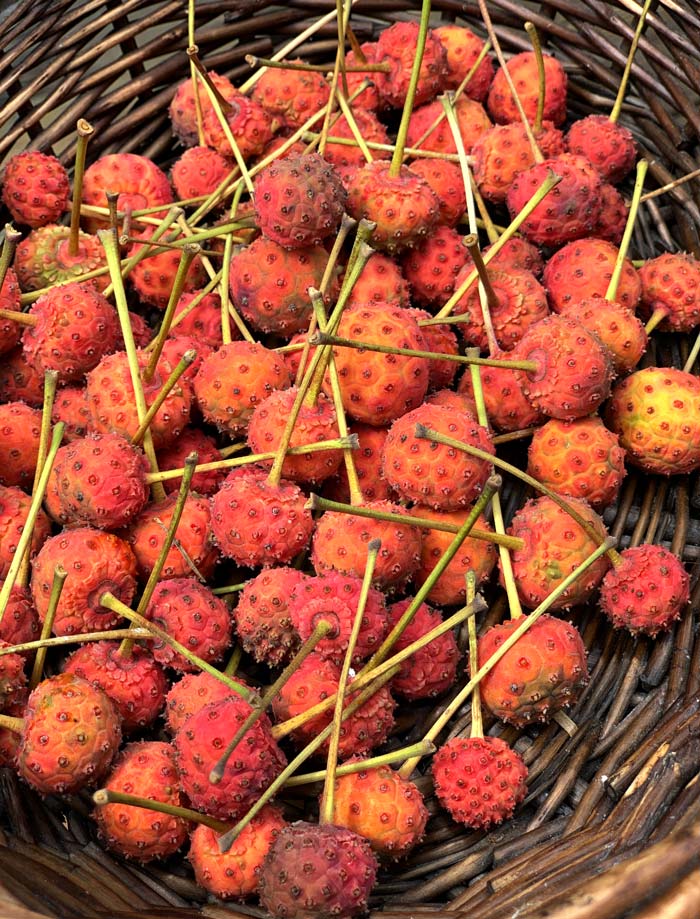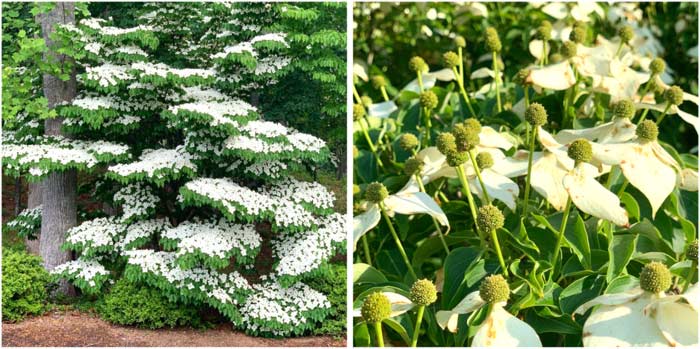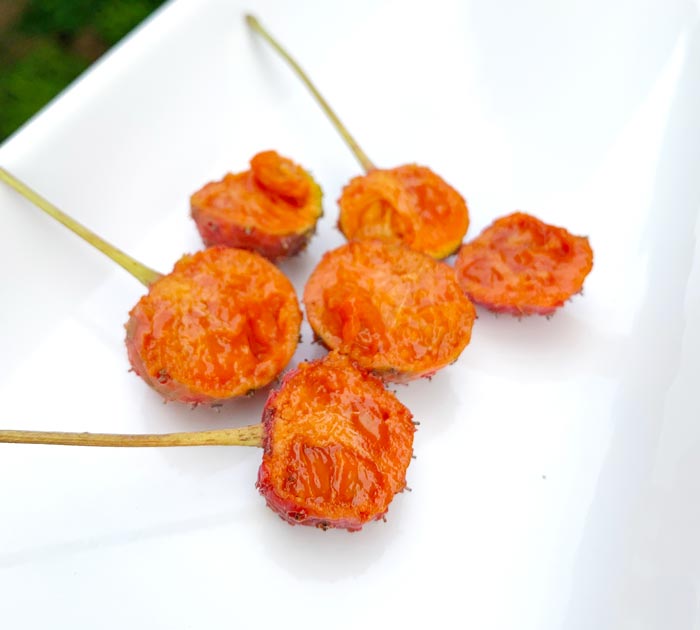Last Updated on May 24, 2022 by Aaron von Frank
Asian Kousa dogwoods (Cornus kousa) are a beautiful tree that also produce a tasty edible fruit. Here’s everything you need to know to grow, ID, and eat Kousa dogwood fruit.
Every month and season brings new foods to our table. With the arrival of late summer (it’s the end of August as of the writing of this article), The Tyrant and I decided to go check out some of our nearby urban foraging spots.
No, this did not require us to go deep down a forested trail or into the nearby mountains. Instead, we drove a couple miles to an undisclosed location (hey, we can’t give up our best spots!) where landscapers long ago decided to plant Kousa dogwoods.

The first Kousa dogwood fruit of the late summer season in Greenville, South Carolina.
Whoever this person or people were, we are enormously grateful to them. By doing so, they freed up space in our yard for other large perennial fruit & nut-producing trees. We’d initially considered growing Kousa dogwoods in our food forest, but upon finding a nearby spot full of mature Kousas, we decided against it.
Is this theft? No, unless you consider stealing fruit from squirrels, yellow jackets and other insects to be theft. As it turns out, nobody who frequents our Kousa dogwood spot seems to know that they’re an edible fruit — or if they do, they don’t care. Whatever fruit we don’t pick falls to the ground and rots, and the landscapers weed whack whatever seedlings sprout up the following year.
In this article, we’ll share everything we know about Kousa dogwoods so you can find them, grow them, and enjoy this wonderful fall fruit as well!
Your Kousa dogwood questions answered
Are dogwood fruits poisonous?
As we state in our Beginner’s guide to foraging, rule #1 of foraging or eating any new food you’re unfamiliar with is: Never eat anything you’re not 100% certain you’ve correctly ID’d AND you’re not 100% certain is edible.
The same applies to the fruit of dogwood trees, some of which are edible some of which are not:
- Cornus florida, the dogwood species native to the Southeastern US, produces small red berries in the fall that are mildly poisonous to humans. (They’re also supposed to taste terrible, although we’ve never tried them because, well, they’re poisonous and supposed to taste bad.)
- Cornus mas, aka Cornelian cherry dogwood, is another imported landscape plant native to Eurasia that produces an edible fruit. We’ve never eaten them, but these are supposed to be quite good, although sour. Excellent for jams and pies once the seeds are strained out.
- Cournus kousa, aka Kousa dogwood or Asian dogood, is the subject of this article. It’s native to Japan, Korea, and China, and produces an edible fruit in late summer.

Kousa dogwood fruit – edible and quite delicious!
The fruit of Kousa dogwoods is often called a berry, but it’s technically an aggregate fruit that somewhat resembles a raspberry, although it’s much larger.
When do you harvest and eat Kousa dogwood fruit?
In our area, Kousa dogwoods produce bracts (modified leaves that look like flowers) in May.

Left: Gorgeous Kousa dogwood (Cornus kousa) flowers/bracts on display in early May in Greenville, SC. Right: Immature fruit developing in late May. These showy plants make a great addition to an edible landscape!
The fruit begins ripening from green to orange/red in late August and finishes up by mid-September.
How do you know when Kousa dogwood fruit is ripe?
Here are three ways to tell if a Kousa dogwood fruit is ripe:
- the fruit’s skin should be orange-red in color with some color variability between trees and cultivars;
- the fruit should be slightly soft to the touch (not squishy);
- ripe fruits fall off the tree and can be gathered on the ground OR can be easily pulled off of the tree.

The Khousa dogwood fruit in my hand is not quite ripe yet (still a bit green). The ones in the bottom right corner of the picture are ripe.
What does the fruit taste like?
Kousa dogwood fruit tastes quite similar to ripe American persimmons (with zero pucker). In our experience, there is variability in taste between trees and varietals – some fruit we’ve had is deep orange in color with richer flavor, and others are yellow-fleshed and lighter in flavor.
We’ve also had kousa fruit that was so sickeningly sweet is was inedible. So get to know your trees and which ones produce the best fruit!

A look inside Kousa dogwood fruit. Some trees produce yellow-fleshed fruit, others produce orange-red fleshed fruit.
How do you eat Kousa dogwood fruit?
Two negative factors about Kousa dogwood fruit are:
- The skin is rough and gritty/mealy, therefore isn’t ideal for eating;
- Most Kousa dogwood fruit has fairly large seeds inside relative to the size of the fruit (the seeds are about the size of a pomegranate seed).
That means you probably won’t want to ingest the entire fruit, skin, seeds, and all.
If you’re eating Kousa dogwood fruit fresh, the best way to do it is to pull off the stem, which makes a small opening at the top of the fruit. Then, squeeze the inner goodness into your mouth before spitting out the seeds. No, it’s not an elegant process.

How to eat a Kousa dogwood fruit from left to right.
Cooking with Kousa dogwood fruit
Want to find out how to process kousa dogwood fruit into pulp or use that pulp to make delicious recipes?
Check out our kousa dogwood pudding-cake recipe!

Tyrant Farms’ kousa dogwood pudding cake recipe. You’ll want to bookmark this one and use it year after year!
How do you grow Kousa dogoods?
Kousa dogwoods are about as low-maintenance as trees come, so even if you don’t think you have a green thumb, you can grow them in your garden or edible landscape.
Kousa dogwood hardiness zones
Kousa doogwoods grom in USDA Agricultural Zones 5-8. If you don’t know your Ag Zone, you can find it here.
Kousa dogwood sun and soil requirements
Unlike most fruit trees, Kousa dogwood can perform quite well in part shade. They actually prefer a spot with morning sun and afternoon shade.
The spot we go to forage our Kousa dogwood fruit has trees growing in full sun and in part-full shade, so we get to see a side-by-side comparison. The full sun trees produce more fruit, but the fruits are smaller, possibly due to the soil drying out more. The trees growing in shadier spots produce less fruit, but the fruit is larger.

The Tyrant picking Kousa dogwood fruit on one of the full-sun trees.
Kousa dogwoods grow best in well-draining but moist acidic soil. They do not like wet or waterlogged soil.
If you live in hot dry area or are experiencing a drought, you’ll want to irrigate your young Kousa dogwoods – about 1″ of water per week until they’re established. After 3-5 years, they shouldn’t require additional irrigation if you regularly get rain.
To promote optimal soil moisture levels and soil fertility for your Kousa dogwoods, top-dress around the trees with 3-6″ of wood chips/mulch once or twice per year. (Read more about the benefits of using wood chips and mulches).
Are kousa dogwoods self-fertile?
Yes, kousa dogwoods are hermaphroditic, with both male and female parts on the bracts. That means you can plant only a single tree and still get fruit production.
How many years before Kousa dogwoods produce flowers or fruit?
Kousa dogwood trees take 5-7 years before they produce flowers and fruit.
How big do Kousa dogwood trees get?
Kousa dogwoods are considered small to medium sized trees. They mature to about 30 feet tall x 30 feet wide (their width and height are roughly equal at maturity) once they reach 20-30 years old.
Kousa dogwoods can live to be over 100 years. When they’re young, they grow more upright and vase shaped before spreading and rounding out into their final mature form.
The trees are a beautiful landscape plant as well. They produce beautiful white or pink bracts in late spring and have attractive foliage all summer long. In the fall, the leaves turn red and purple before dropping to reveal smooth and beautiful grey-brown bark that looks much more similar to a crepe myrtle tree’s bark than to our native dogwood.
Are Kousa dogwoods deer-resistant?
No, deer do not like Kousa dogwoods. In fact, Arbor Day Foundation lists Kousa dogwoods as “seldom severely damaged, the second highest degree of deer resistance a tree can receive.”
(If you have deer problems, be sure to read our article Dad’s trick: how to keep deer out of your garden or yard.)
Can you grow them from seeds? Where can you buy good Kousa dogwood saplings?
Yes, you can grow Kousa dogwoods from seed, but add 1-2 years to fruit production using this method relative to buying saplings.
There are quite a lot of Kousa dogwood cultivars out there with subtle differences between them. Some have pink “flowers” (technically bracts), some have white flowers. Some have orange-skinned fruit, some have red.
Ideally, find a variety bred specifically for its fruit quality. Call your local plant nurseries to see what they have available or order your Kousa dogwood saplings online.
Whether you grow your own Kousa dogwood fruit or get lucky and find nearby fruit-bearing trees, we hope you’ll enjoy this wonderful Asian fruits in the late summer each year. Happy gardening or foraging!
KIGI,

Other articles you might enjoy:
- The complete guide to growing elderberry trees
- How to grow pawpaw trees (America’s largest and tastiest native fruit)
- Perennial power: 5 fruit or nut trees you should plant this fall

Like what you're seeing here? Please be sure to subscribe to Tyrant Farms so we can let you know about new articles you'll love.



14 Comments
Richard Stevens
September 8, 2023 at 10:27 amFrom what i can tell no cultivars have been selected for fruit flavor. In fact some nurseries even list the fruit as not edible. :). If you know a cultivar that is particularly good please post.
Aaron von Frank
September 8, 2023 at 10:41 amWe don’t know any specific Kousa dogwood cultivars that are ideal for edibility. Two possible ways to select for good fruit: 1) try to sample ripe fruit from a named cultivar, 2) take graft cuttings from a tree that produces good fruit then graft it to rootstock.
SALLY ANN BAKER
October 1, 2021 at 4:13 pmI have a mature Kousa dogwood in my backyard, and it is my pride & joy. Most folks are skeptical when I tell them the fruit is edible. Thank you for an informative article.
Aaron von Frank
October 2, 2021 at 1:44 pmGlad you enjoyed the article, thanks Sally! Yes, kousa dogwood fruits are edible and almost always quite delicious. We have found a few trees here and there that produce somewhat bitter or even insipidly sweet fruit. However, more often than not they’re wonderful, with a flavor approximating pawpaws or American persimmons. They also happen to be beautiful trees in a landscape.
Joseph Winter
May 14, 2021 at 5:46 pmDefinitely get a food mill. It’s a conical sieve surrounding an auger, fed by a funnel. Fabio Leonardi is a good brand I use for tomato and apple sauces.
Denise C Yates
November 29, 2020 at 6:45 pmSo…I have a chinois (food mill) AND I used it successfully to seperate the seeds, skin, & pulp! Leaving me with 12 cups of pureed pulp. I made kousa bread, kousa muffins, & then I froze 2 3 cup containers. I just thawed out one container and made kousa berry jam!!
Aaron von Frank
November 29, 2020 at 10:00 pmWell, dang. We have a chinois – going to have to give this a shot next summer. How did your recipes turn out?
Marilyn Lasiter
May 31, 2022 at 12:10 pmSound delish!
Margie
October 15, 2020 at 9:27 amI just used what I know as a grister and it worked fabulous in separating pulp from seeds and skin. About 25 min of washing, de-stemming, and frosting fruit yielded me about 4 cups of yummy pulp!
Aaron von Frank
October 15, 2020 at 10:18 pmGood to know, thanks Margie! Got any special plans for your Kousa dogwood pulp or just going to enjoy it as-is?
Anne Burke
August 28, 2019 at 1:07 pmhow about using a food mill to separate seeds and pulp?
Aaron von Frank
August 28, 2019 at 2:56 pmThat might very well work! We don’t have a food mill, so are unable to give it a try. If you do try it, please let us know how it turns out.
Anne Burke
August 29, 2019 at 3:07 pmI have a food mill but no Kousa fruit. You should ask around – maybe a friend has one. I mostly use mine for jams, fruit butters, and tomato sauces. Separating small seeds is no problem but when doing something like plums or persimmons, I find that the bigger seeds are a little more work. When doing apples, you can just wash and quarter them and when you put them through the mill, the seeds and skins stay behind. I wonder whether the thick Kousa skin would behave the same way or would you have to remove the pulp and seeds before processing further.
Aaron von Frank
August 29, 2019 at 6:01 pmIf you (or anyone else) tries Kousas in a food mill, I’d definitely recommend squeezing the pulp out and removing the skins first. The skins are crispy and have a lot of grit in them, which could ruin the final product if it went through.